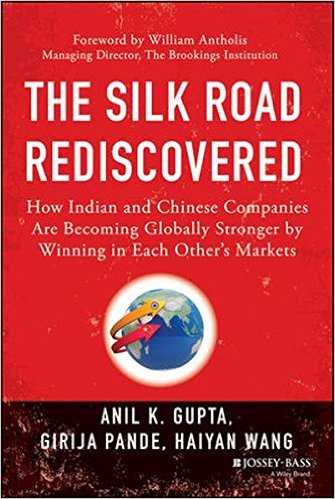Smart Globalization — Building and Leveraging Global Presence
Globalization is a double-edged sword. The global or globalizing firm has the potential to reap several types of benefits — the vast potential of a much larger market arena, providing coordinated products ands services to global customers, capturing scale- and location-based cost efficiencies, and exposure to a multiplicity of new product and process ideas.
However, globalization also exposes the firm to numerous strategic and organizational challenges emanating from a dramatic increase in diversity, complexity, and uncertainty — external as well as internal to the firm. How managers address these challenges determines whether globalization yields competitive advantage or disadvantage and makes the company stronger or weaker. "Smart Globalization" is the ability to capture the benefits and minimize the costs and risks.
Using real-world examines, in this talk, Professor Gupta discusses how corporate leaders can systematically globalize their firms' market presence, what logic should guide them in leveraging the world's physical, technological and talent resources to create competitive advantage, and what they must do to globalize the mindset of the people in the company.
Cultivating A Global Mindset
In 2000, Chrysler's then president traveled to India to study the market. At the end of his visit, remarked: "Call me when you've built some roads." He simply didn't anticipate that the Indian auto market would grow by over 500% over the next 10 years. India's car sales shot up from 518,000 units in 2000 to 2.8 million in 2010, making it the world's sixth largest. Not surprisingly, Chrysler is notable for its near-absence. In 2014, Chrysler-Fiat's share in India was a mere 0.4%.
As this story illustrates, we are in the middle of a radical paradigm shift in the global economic landscape. Non-linear changes are particularly risky times for companies and people entrenched in old mindsets. No longer can you continue to rely on old lenses to make sense of the world around you. The winning global leaders, whether individuals or companies, will be the ones with a global mindset who truly grasp the unprecedented transformation of the global economy, and possess the capabilities to sense, filter, and integrate diverse opportunities on a global scale ahead of the pack.
Through real-world examples, Professor Gupta illustrates how a global mindset can enable a company to be an early mover in identifying new opportunities in global markets. It also offers concrete guidelines that individuals and companies can use to develop a global mindset, which requires not only local depth (i.e., an openness to and knowledge of diversity across cultures and markets), but also global connect (i.e., the ability to integrate across this diversity).
Global Enterprise 2020
The structure and dynamics of the global economy are changing rapidly. Despite the ups and downs in individual economies, emerging markets as a group continue to grow at three times the pace of developed markets; by 2025, they will account for over half of the world's GDP. The diffusion of mobile broadband to every corner of the earth continues to make cross-border collaboration easier, cheaper, and more ubiquitous. And, the technology revolution continues unabated — electric and/or autonomous cars, wearable computing, genetic engineering, shale oil and gas, human-scale robots, etc. These developments will lead to the disruption of industries at an even faster pace than what we've seen over the last decade.
Given these developments, what must today's corporations do to emerge or remain as the global leaders in their industries ten years from now? The answer lies in: (i) rethinking global strategy i.e., commitment to emerging markets, atomization of the value chain, and leveraging global platforms to create highly customized local solutions; (ii) rethinking global innovation i.e., 360-degree innovation, distributed innovation, open innovation, and frugal innovation; (iii) rethinking global organization i.e., connect-and-coordinate rather than command-and-control plus a strong one-company culture; and (iv) globalizing the corporate mindset i.e., cultivating leaders who combine in-depth knowledge of key markets and cultures with an ability to connect the dots globally.
Getting China and India Right
For almost three decades, China and India have been the two most dynamic emerging markets in the world. Unlike Latin America or Africa, both countries are resource poor. Yet, since 1990, both have been the world's two fastest growing large economies. The answer lies in the ability of the two countries to boost the productivity of their peoples at some of the most rapid rates in the world.
As of 2015, China is the world's second largest economy and India the eighth largest — at market exchange rates. By 2025, while China would have reduced the size gap with the United States, India is likely to have overtaken Italy, France, UK, Germany and even Japan to become the third largest. By the middle of the 21st century, both China and India are likely to overtake the U.S. also to become the world's two largest economies. In many ways, this will be a back-to-the-future story, since China and India were the world's two largest economies for much of recorded history. They became poor only during the 19th and 20th centuries when the industrial revolution passed them by.
As China and India continue to rise, they are transforming the global economy in multiple ways:
-They are two of the world's biggest and fastest growing markets for almost every product or service.
-They are two of the world's most important platforms for cost reduction for both blue- and white-collar work.
-They are the world's two most important rising powers for technology and innovation.
-They are also the world's most prolific springboards for the emergence of new, powerful, and ambitious global competitors.
In this talk, Professor Gupta discusses the factors propelling China and India, the challenges that each country faces, and implications of these developments for multinational corporations.
Asia's Rise and Its Implications
Asia's rise will be one of the defining game changers for the global economy in the 21st century. Asia today accounts for about a third of the world's GDP as compared with about a quarter each for North America and Europe. Since Asia continues to grow faster than each of the other two continents, it is almost certain that, by 2025, Asia's GDP will be larger than that of the US and Europe combined. Further, Asia's impact on the global economy is multidimensional — as a mega-market, as the world's factory, as a rising hub for global R&D, as a source of capital, and as the springboard for the rise of new global champions. Asia is also becoming more "Asian" in that intra-Asia trade is growing faster than Asia's trade with the rest of the world. This talk will examine the forces propelling Asia's rise and discuss a number of related questions including:
-What are the risks? What could derail Asia's rise?
-What are the implications of China's slowdown for corporations and investors?
-What lies ahead for India and Indonesia, the two largest Asian emerging economies after China?
-How should MNCs prepare themselves to benefit from Asia's rise?
-Implications for investors? And, for young managers?
Emerging Markets: Diverging Futures
Ever since Goldman Sachs' prescient report "Dreaming with BRICs" over a decade ago, emerging markets have been on a ride. From 2000 to 2012, emerging markets' GDP grew at an average annual rate of 6 percent, over three times the pace of the below 2 percent annual growth for the developed markets. As a direct result, emerging markets' share of the global economy doubled from 17 percent in 2000 to 32 percent in 2012. Never before in the history of the world, has 80 percent of the world's population become better off at the pace that it has since the turn of the 21st century.
Notwithstanding this glorious ride, it is clear that, since early 2013, the bloom has fallen off the emerging markets. China is undergoing a structural slowdown from an above 10 percent growth rate to around 6-7 percent. India has gone from 9 percent to around 5 percent. Economic growth in Brazil and Russia is hovering around one percent. Many other markets such as Indonesia, Thailand, Turkey and South Africa also appear to be mired in significant turmoil. These developments raise one of the most important questions facing every enterprise and every investor — Is the emerging market story over?
In this talk, Professor Gupta addresses this question head on. His central message is that the days of emerging markets moving up in tandem are indeed over. China is unlikely to remain the driver of a worldwide commodity boom. Similarly, the U.S. is unlikely to remain the font of easy money for much of the world. From here on, only those emerging markets that are able to undertake much needed internal reforms (stable governments, investment in infrastructure and education, and institutions that are efficient as well as responsive to citizens' needs) can hope to thrive. Others run a serious risk of being trapped at their current low- or middle-income status for a very long time. Professor Gupta also shares his analysis of which countries appear to be better bets than others and what these developments mean for companies and investors.





